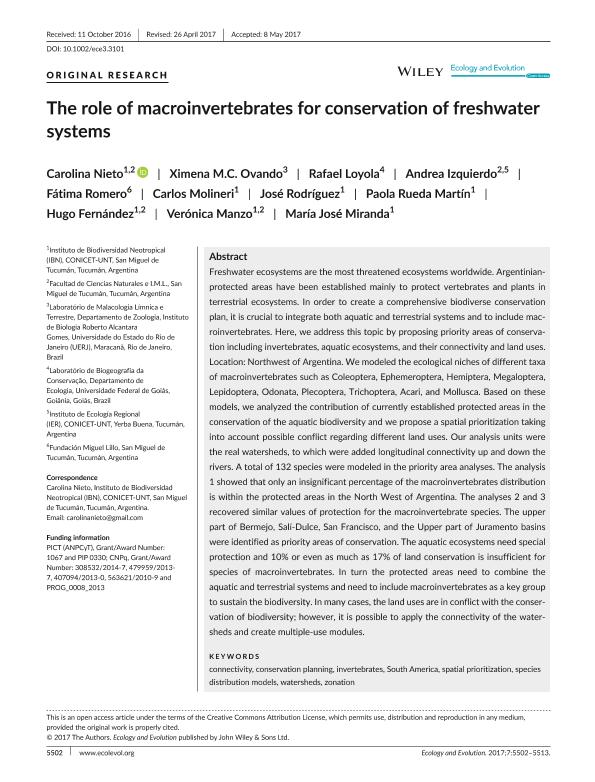Artículo
The role of macroinvertebrates for conservation of freshwater systems
Nieto Peñalver, María Carolina ; Ovando, Ximena Maria Constanza
; Ovando, Ximena Maria Constanza ; Loyola, Rafael; Izquierdo, Andrea Elisa
; Loyola, Rafael; Izquierdo, Andrea Elisa ; Romero, Vivian de Fátima; Molineri, Carlos
; Romero, Vivian de Fátima; Molineri, Carlos ; Rodríguez, José; Rueda Martin, Paola Alejandra
; Rodríguez, José; Rueda Martin, Paola Alejandra ; Fernandez, Hugo Rafael
; Fernandez, Hugo Rafael ; Manzo, María Verónica
; Manzo, María Verónica ; Miranda, Maria Jose
; Miranda, Maria Jose
 ; Ovando, Ximena Maria Constanza
; Ovando, Ximena Maria Constanza ; Loyola, Rafael; Izquierdo, Andrea Elisa
; Loyola, Rafael; Izquierdo, Andrea Elisa ; Romero, Vivian de Fátima; Molineri, Carlos
; Romero, Vivian de Fátima; Molineri, Carlos ; Rodríguez, José; Rueda Martin, Paola Alejandra
; Rodríguez, José; Rueda Martin, Paola Alejandra ; Fernandez, Hugo Rafael
; Fernandez, Hugo Rafael ; Manzo, María Verónica
; Manzo, María Verónica ; Miranda, Maria Jose
; Miranda, Maria Jose
Fecha de publicación:
07/2017
Editorial:
John Wiley and Sons Ltd
Revista:
Ecology and Evolution
ISSN:
2045-7758
Idioma:
Inglés
Tipo de recurso:
Artículo publicado
Clasificación temática:
Resumen
Freshwater ecosystems are the most threatened ecosystems worldwide. Argentinian-protected areas have been established mainly to protect vertebrates and plants in terrestrial ecosystems. In order to create a comprehensive biodiverse conservation plan, it is crucial to integrate both aquatic and terrestrial systems and to include macroinvertebrates. Here, we address this topic by proposing priority areas of conservation including invertebrates, aquatic ecosystems, and their connectivity and land uses. Location: Northwest of Argentina. We modeled the ecological niches of different taxa of macroinvertebrates such as Coleoptera, Ephemeroptera, Hemiptera, Megaloptera, Lepidoptera, Odonata, Plecoptera, Trichoptera, Acari, and Mollusca. Based on these models, we analyzed the contribution of currently established protected areas in the conservation of the aquatic biodiversity and we propose a spatial prioritization taking into account possible conflict regarding different land uses. Our analysis units were the real watersheds, to which were added longitudinal connectivity up and down the rivers. A total of 132 species were modeled in the priority area analyses. The analysis 1 showed that only an insignificant percentage of the macroinvertebrates distribution is within the protected areas in the North West of Argentina. The analyses 2 and 3 recovered similar values of protection for the macroinvertebrate species. The upper part of Bermejo, Salí-Dulce, San Francisco, and the Upper part of Juramento basins were identified as priority areas of conservation. The aquatic ecosystems need special protection and 10% or even as much as 17% of land conservation is insufficient for species of macroinvertebrates. In turn the protected areas need to combine the aquatic and terrestrial systems and need to include macroinvertebrates as a key group to sustain the biodiversity. In many cases, the land uses are in conflict with the conservation of biodiversity; however, it is possible to apply the connectivity of the watersheds and create multiple-use modules.
Archivos asociados
Licencia
Identificadores
Colecciones
Articulos(IBN)
Articulos de INSTITUTO DE BIODIVERSIDAD NEOTROPICAL
Articulos de INSTITUTO DE BIODIVERSIDAD NEOTROPICAL
Citación
Nieto Peñalver, María Carolina; Ovando, Ximena Maria Constanza; Loyola, Rafael; Izquierdo, Andrea Elisa; Romero, Vivian de Fátima; et al.; The role of macroinvertebrates for conservation of freshwater systems; John Wiley and Sons Ltd; Ecology and Evolution; 7; 14; 7-2017; 5502-5513
Compartir
Altmétricas



